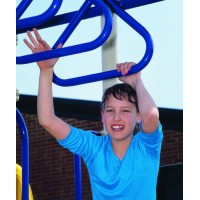Climbing and Upper Body Equipment

Public Playground Safety Handbook - CPSC Publication 325
U.S. Consumer Product Safety Commission
5.3.2 Climbing and Upper Body Equipment
Climbing equipment is generally designed to present a greater degree of physical challenge than other equipment on public playgrounds. This type of equipment requires the use of the hands to navigate up or across the equipment.“Climbers” refers to a wide variety of equipment, such as but not limited to:
• Arch climbers
• Dome climbers
• Flexible climbers (usually chain or net)
• Parallel bars
• Sliding poles
• Spiral climbers
• Upper body equipment (horizontal overhead ladders, overhead rings, track ride).
School-age children tend to use climbing and upper body equipment more frequently and more proficiently than preschool children. Young preschool children may have difficulty using some climbers because they have not yet developed some of the physical skills necessary for certain climbing activities (balance, coordination, and upper body strength). Older preschool children (i.e., 4- and 5-year-olds)are beginning to use flexible climbers, arch climbers, and upper body devices.
5.3.2.1 Design considerations
5.3.2.1.1 Layout of climbing components
When climbing components are part of a composite structure, their level of challenge and method of use should be compatible with the traffic flow from nearby components. Upper body devices should be placed so that the swinging movement generated by children on this equipment cannot interfere with the movement of children on adjacent structures, particularly children descending on slides. The design of adjacent play structures should not facilitate climbing to the top support bars of upper body equipment.
5.3.2.1.2 Fall Height
Climbers:
• Unless otherwise specified in this section, the fall height for climbers is the distance between the highest part of the climbing component and the protective surfacing beneath it.
• If the climber is part of a composite structure, the fall height is the distance between the highest part of the climber intended for foot support and the protective surfacing beneath it.
– Toddlers: The maximum fall height for free standing and composite climbing structures should be 32 inches.
Upper Body Equipment:
• The fall height of upper body equipment is the distance between the highest part of the equipment and the protective surface below.
